TMEM16 proteins: Ca2+‑activated chloride channels and phospholipid scramblases as potential drug targets (Review)
- Authors:
- Zeqi Huang
- Zoya Iqbal
- Zhe Zhao
- Xiaoqiang Chen
- Ayesha Mahmmod
- Jianquan Liu
- Wencui Li
- Zhiqin Deng
-
Affiliations: Department of Hand and Foot Surgery, Shenzhen Second People's Hospital (The First Hospital Affiliated to Shenzhen University), Shenzhen, Guangdong 518000, P.R. China, Department of Orthopaedics, Shenzhen Second People's Hospital (The First Hospital Affiliated to Shenzhen University), Shenzhen, Guangdong 518000, P.R. China, Faculty of Pharmacy, The University of Lahore, Lahore, Punjab 58240, Pakistan - Published online on: July 29, 2024 https://doi.org/10.3892/ijmm.2024.5405
- Article Number: 81
-
Copyright: © Huang et al. This is an open access article distributed under the terms of Creative Commons Attribution License.
This article is mentioned in:
Abstract
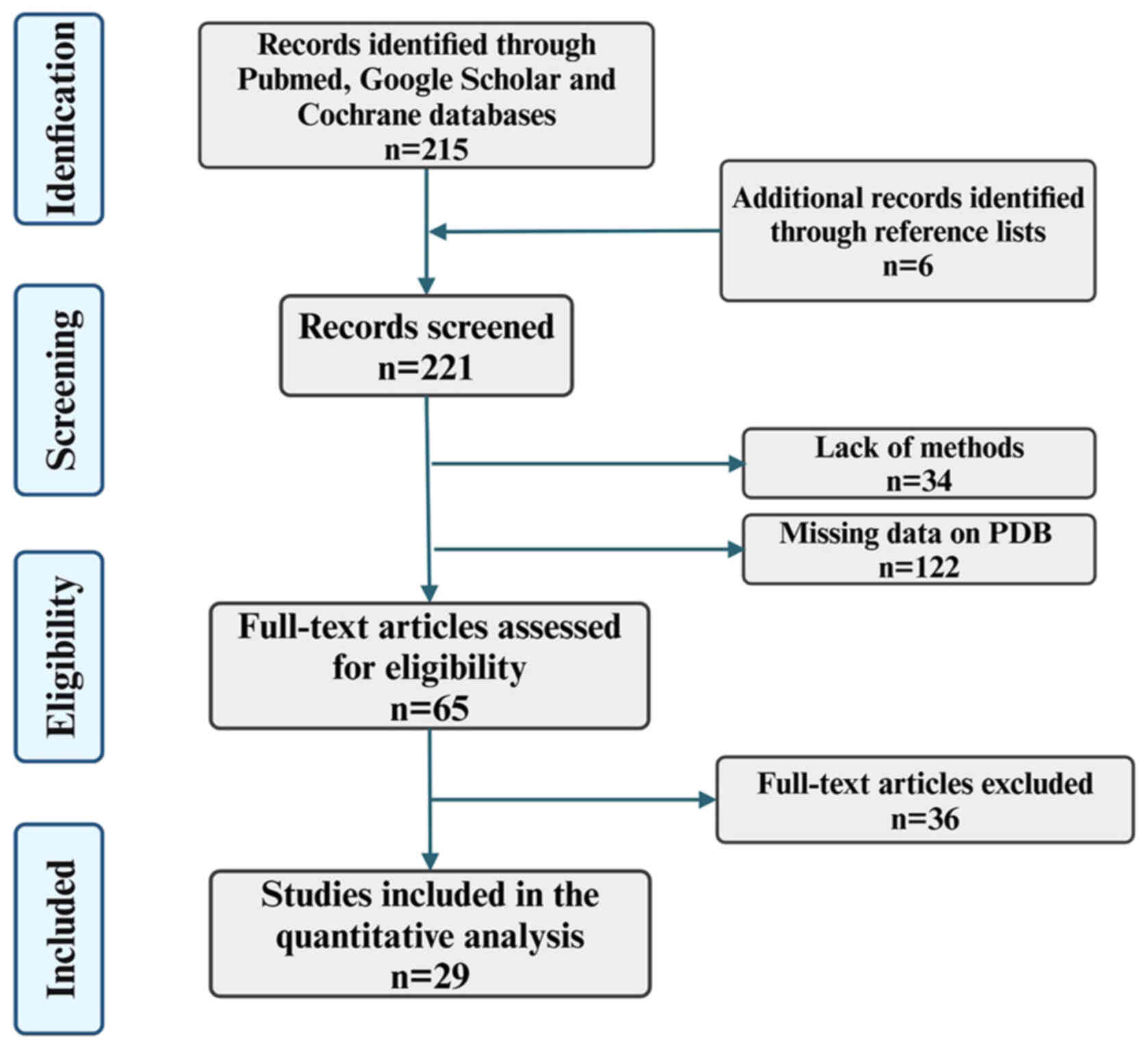 |
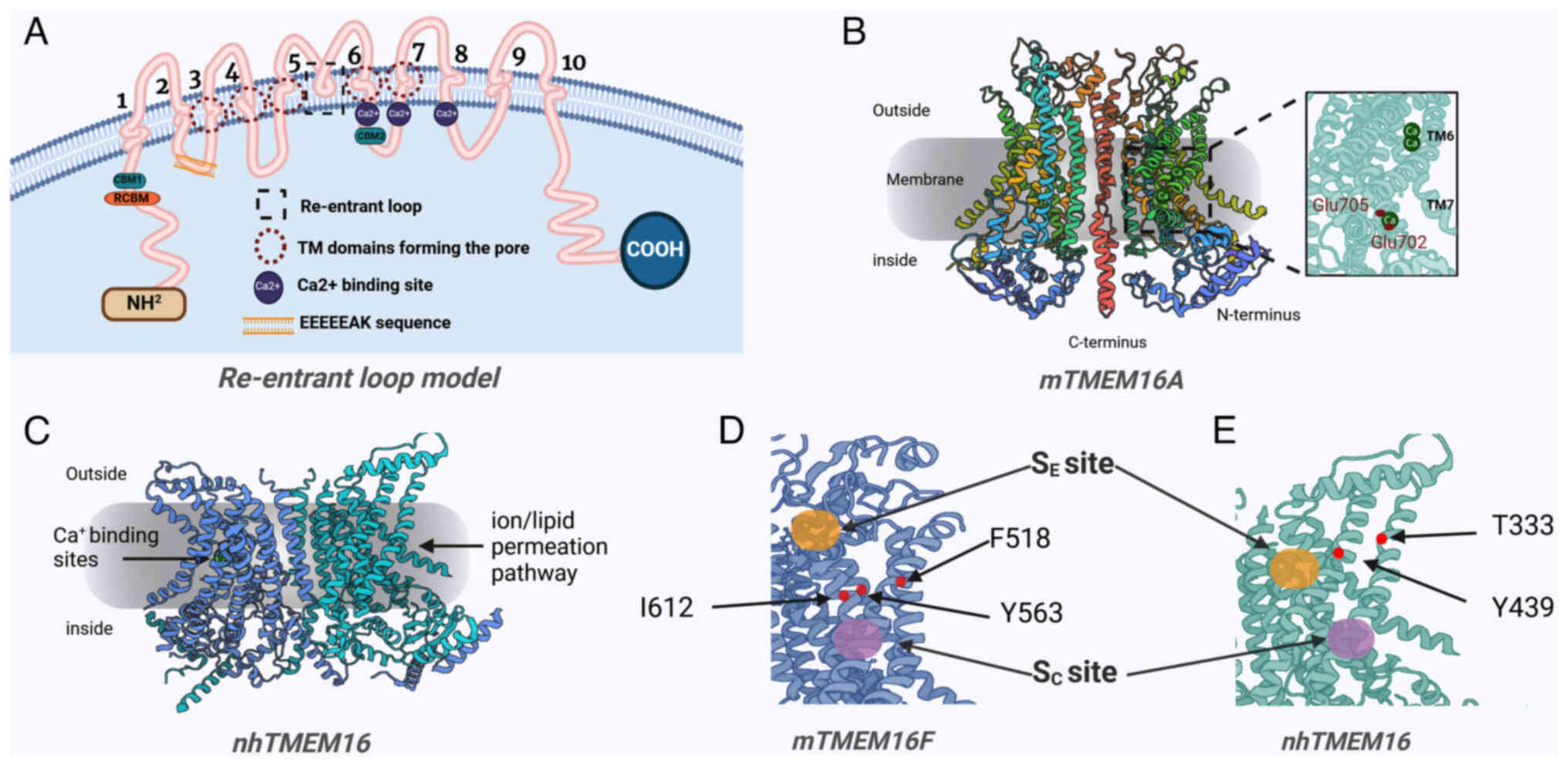 |
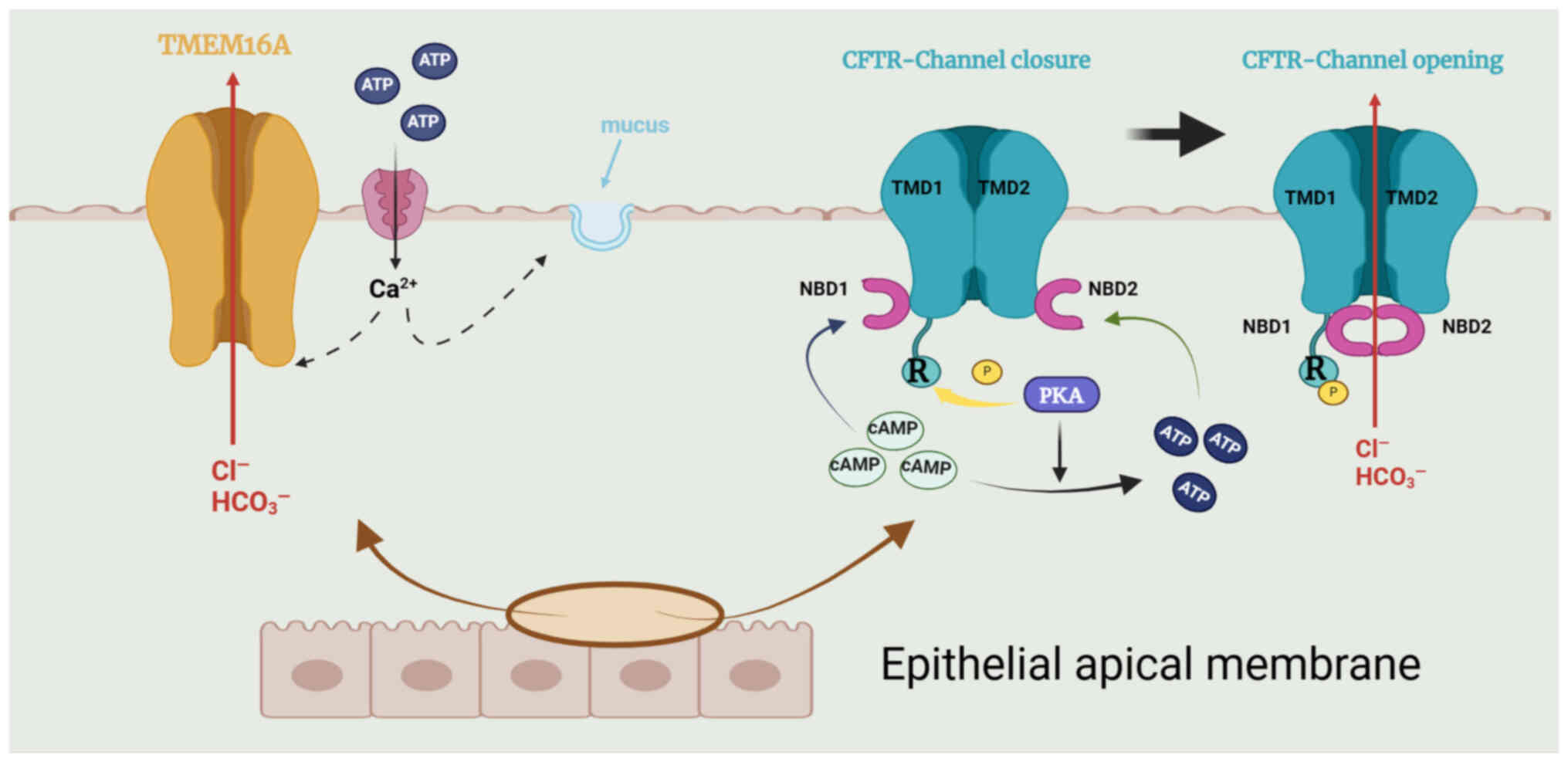 |
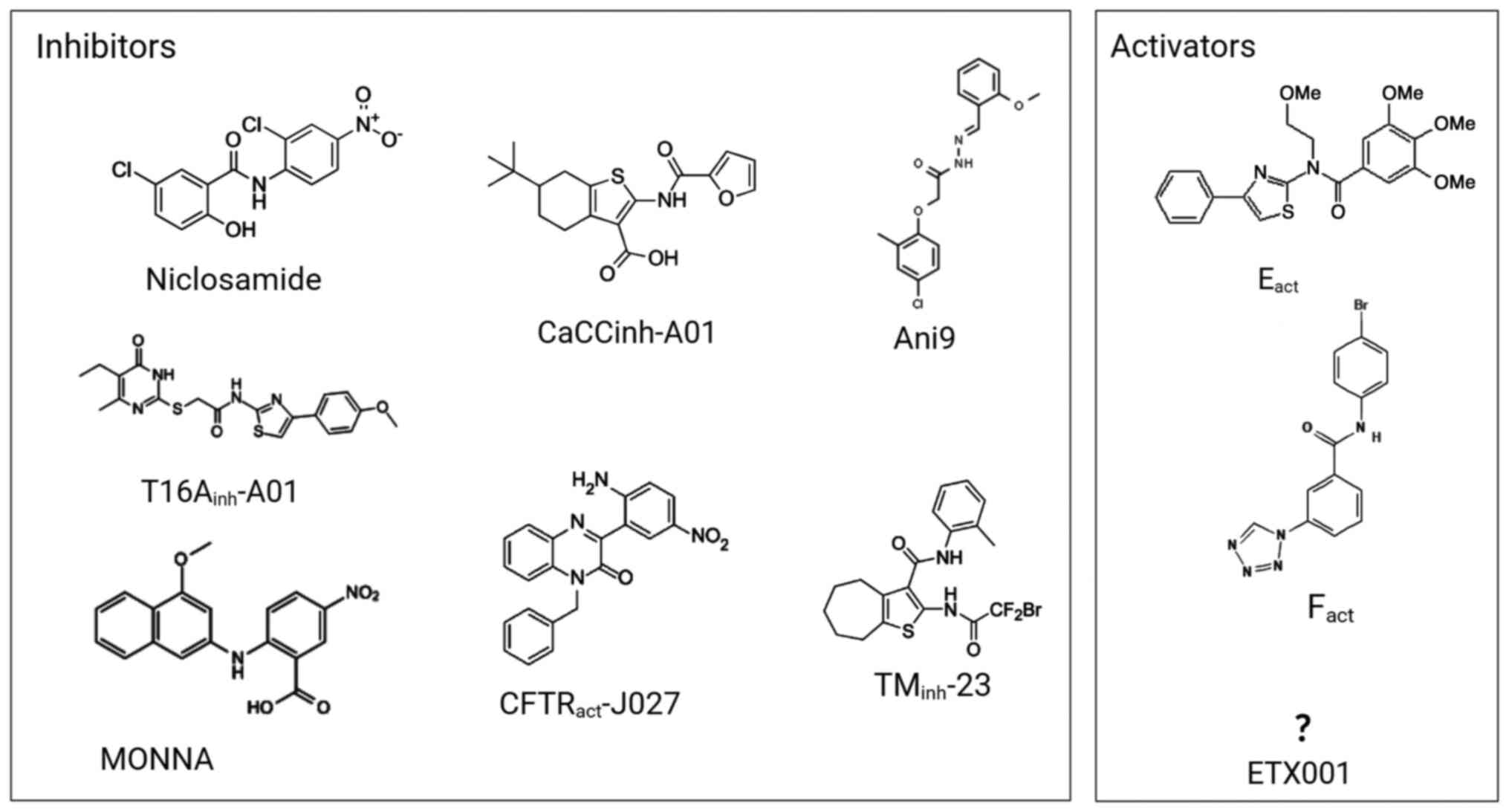 |
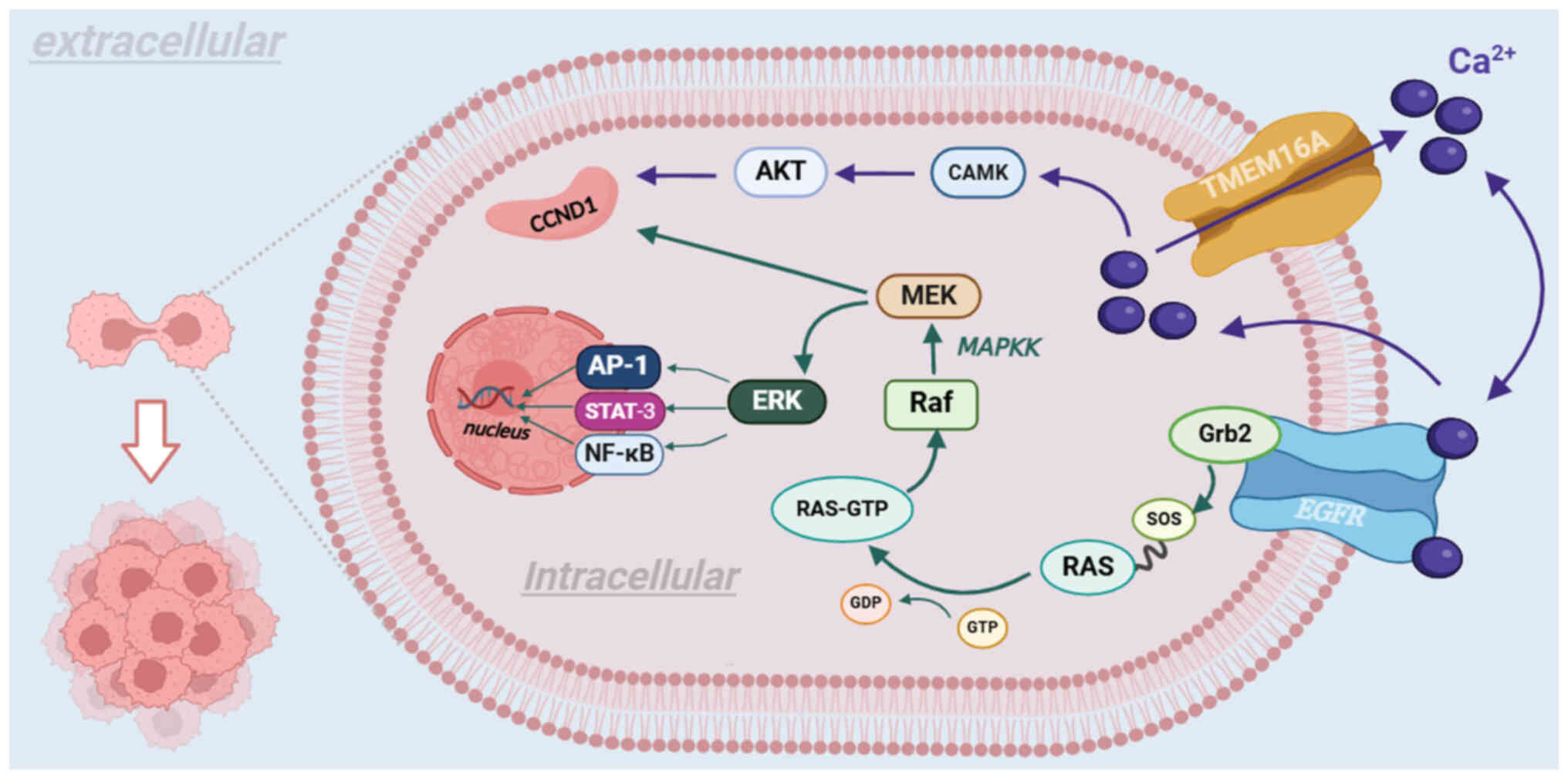 |
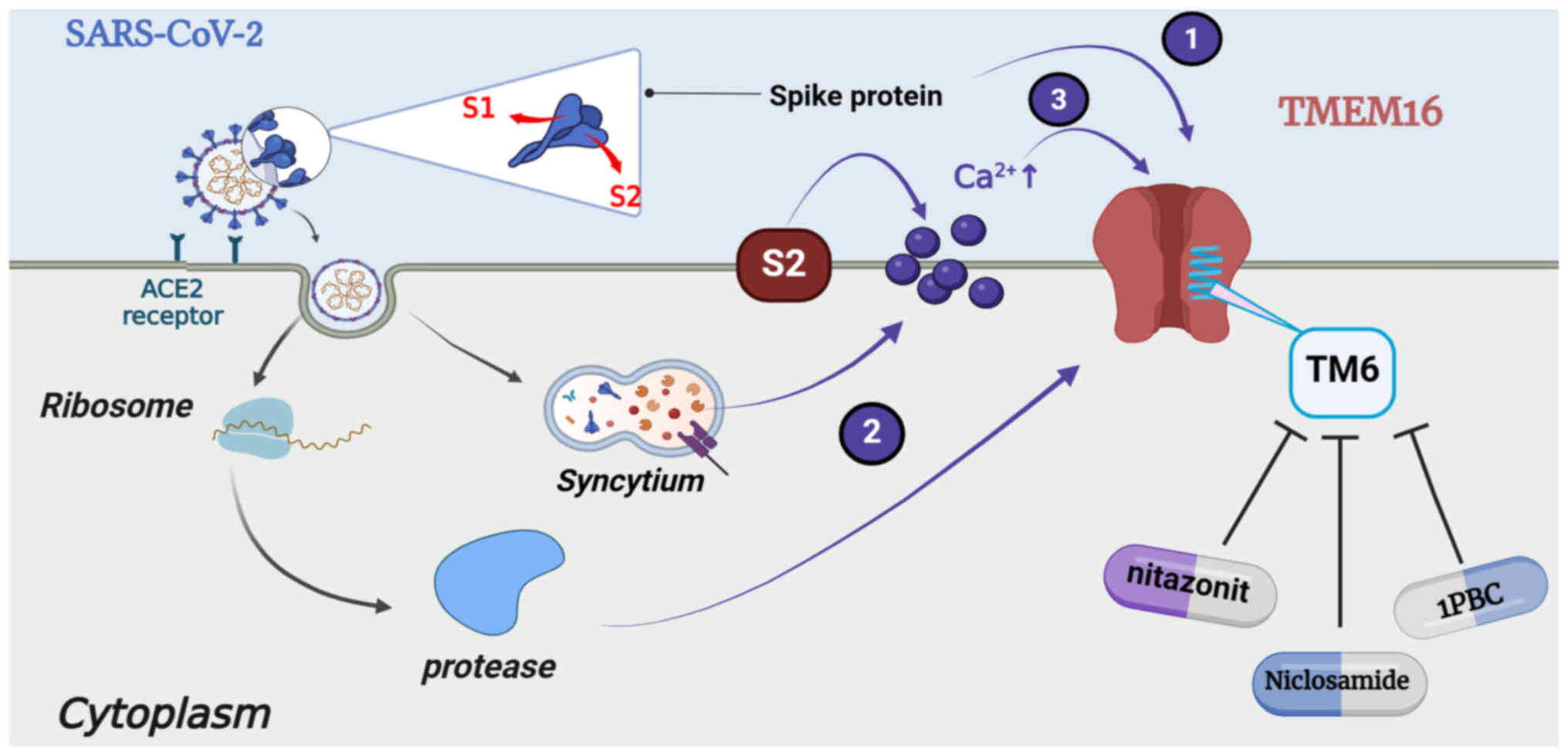 |
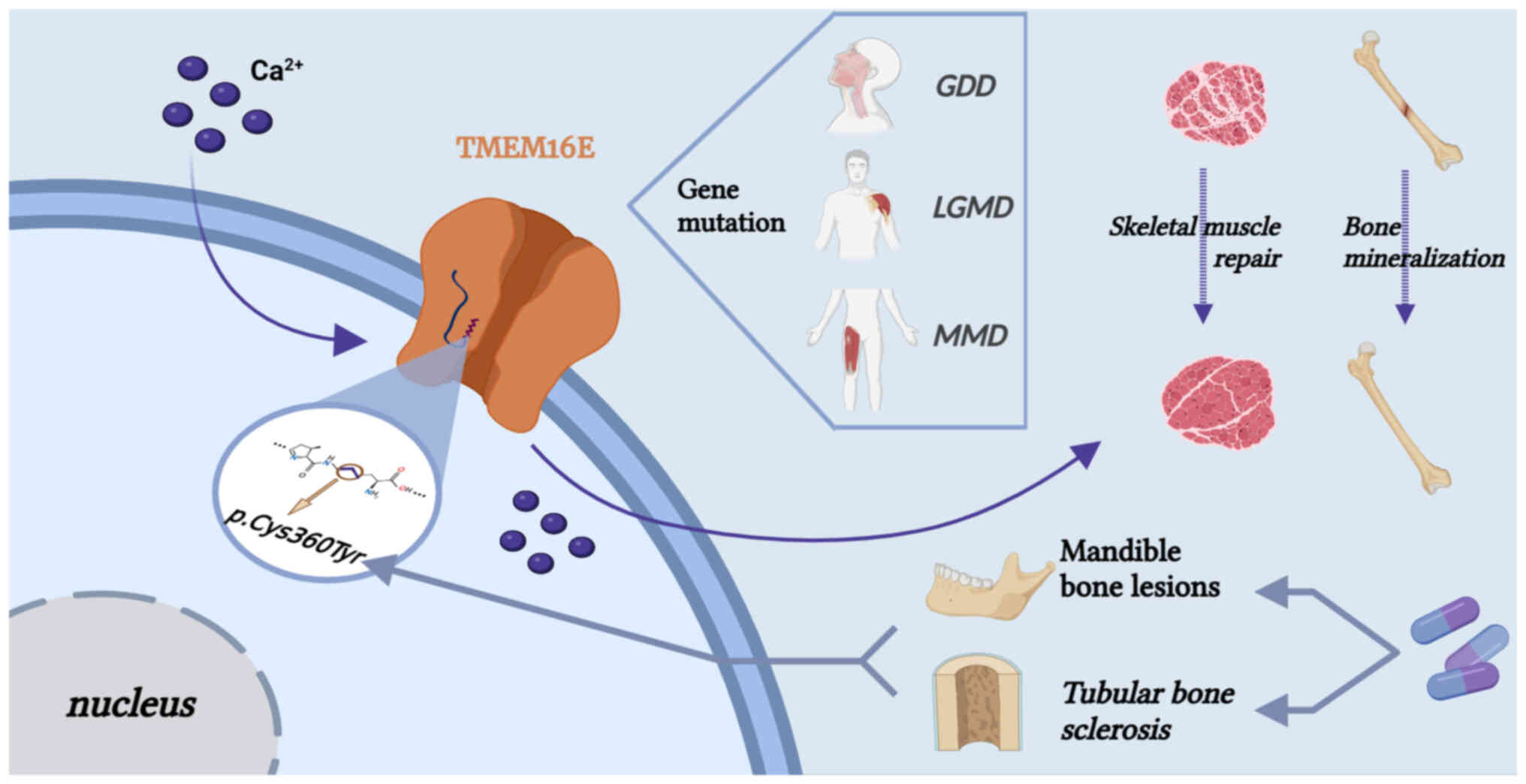 |
|
Vocke K, Dauner K, Hahn A, Ulbrich A, Broecker J, Keller S, Frings S and Möhrlen F: Calmodulin-dependent activation and inactivation of anoctamin calcium-gated chloride channels. J Gen Physiol. 142:381–404. 2013. View Article : Google Scholar : PubMed/NCBI | |
|
Whitlock JM and Hartzell HC: Anoctamins/TMEM16 proteins: Chloride channels flirting with lipids and extracellular vesicles. Annu Rev Physiol. 79:119–143. 2017. View Article : Google Scholar : | |
|
Kunzelmann K, Ousingsawat J, Benedetto R, Cabrita I and Schreiber R: Contribution of Anoctamins to cell survival and cell death. Cancers. 11:3822019. View Article : Google Scholar : PubMed/NCBI | |
|
Scudieri P, Sondo E, Ferrera L and Galietta LJV: The anoctamin family: TMEM16A and TMEM16B as calcium-activated chloride channels. Exp Physiol. 97:177–183. 2011. View Article : Google Scholar : PubMed/NCBI | |
|
Kim H, Kim H, Lee J, Lee B, Kim HR, Jung J, Lee MO and Oh U: Anoctamin 9/TMEM16J is a cation channel activated by cAMP/PKA signal. Cell Calcium. 71:75–85. 2018. View Article : Google Scholar : PubMed/NCBI | |
|
Khelashvili G, Falzone ME, Cheng X, Lee B-C, Accardi A and Weinstein H: Dynamic modulation of the lipid translocation groove generates a conductive ion channel in Ca2+-bound nhTMEM16. Nat Commun. 10:49722019. View Article : Google Scholar : | |
|
Agostinelli E and Tammaro P: Polymodal control of TMEM16x channels and Scramblases. Int J Mol Sci. 23:15802022. View Article : Google Scholar : PubMed/NCBI | |
|
Baethge C, Goldbeck-Wood S and Mertens S: SANRA-a scale for the quality assessment of narrative review articles. Res Integr Peer Rev. 4:52019. View Article : Google Scholar : PubMed/NCBI | |
|
Falzone ME, Malvezzi M, Lee BC and Accardi A: Known structures and unknown mechanisms of TMEM16 scramblases and channels. J Gen Physiol. 150:933–947. 2018. View Article : Google Scholar : PubMed/NCBI | |
|
Falzone ME, Rheinberger J, Lee BC, Peyear T, Sasset L, Raczkowski AM, Eng ET, Di Lorenzo A, Andersen OS, Nimigean CM and Accardi A: Structural basis of Ca2+-dependent activation and lipid transport by a TMEM16 scramblase. ELife. 8:e432292019. View Article : Google Scholar : | |
|
Cheng Y, Feng S, Puchades C, Ko J, Figueroa E, Chen Y, Wu H, Gu S, Han T, Li J, et al: Identification of a conserved drug binding pocket in TMEM16 proteins. Res Sq. View Article : Google Scholar | |
|
Pedemonte N and Galietta LJV: Structure and function of TMEM16 proteins (Anoctamins). Physiol Rev. 94:419–459. 2014. View Article : Google Scholar : PubMed/NCBI | |
|
Yu K, Duran C, Qu Z, Cui YY and Hartzell HC: Explaining calcium-dependent gating of Anoctamin-1 chloride channels requires a revised topology. Circ Res. 110:990–999. 2012. View Article : Google Scholar : PubMed/NCBI | |
|
Jung J, Nam JH, Park HW, Oh U, Yoon JH and Lee MG: Dynamic modulation of ANO1/TMEM16A HCO3− permeability by Ca2+/calmodulin. Proc Natl Acad Sci USA. 110:360–365. 2012. View Article : Google Scholar | |
|
Tian Y, Kongsuphol P, Hug M, Ousingsawat J, Witzgall R, Schreiber R and Kunzelmann K: Calmodulin-dependent activation of the epithelial calcium-dependent chloride channel TMEM16A. FASEB J. 25:1058–1068. 2010. View Article : Google Scholar : PubMed/NCBI | |
|
Hahn A, Salomon JJ, Leitz D, Feigenbutz D, Korsch L, Lisewski I, Schrimpf K, Millar-Büchner P, Mall MA, Frings S and Möhrlen F: Expression and function of Anoctamin 1/TMEM16A calcium-activated chloride channels in airways of in vivo mouse models for cystic fibrosis research. Pflugers Arch. 470:1335–1348. 2018. View Article : Google Scholar : PubMed/NCBI | |
|
Falzone ME, Feng Z, Alvarenga OE, Pan Y, Lee B, Cheng X, Fortea E, Scheuring S and Accardi A: TMEM16 scramblases thin the membrane to enable lipid scrambling. Nat Commun. 13:26042022. View Article : Google Scholar : PubMed/NCBI | |
|
Jansen K and Steurer S: DOG1 expression is in common human tumors: A tissue microarray study on more than 15,000 tissue samples. Am J Clin Pathol. 156(Suppl): S108–S109. 2021. View Article : Google Scholar | |
|
Lam AK and Dutzler R: Calcium-dependent electrostatic control of anion access to the pore of the calcium-activated chloride channel TMEM16A. ELife. 7:e391222018. View Article : Google Scholar : PubMed/NCBI | |
|
Huang WC, Xiao S, Huang F, Harfe BD, Jan YN and Jan L: Calcium-Activated chloride channels (CaCCs) regulate action potential and synaptic response in hippocampal neurons. Neuron. 74:179–192. 2012. View Article : Google Scholar : PubMed/NCBI | |
|
Davis AJ, Forrest AS, Jepps TA, Valencik ML, Wiwchar M, Singer CA, Sones WR, Greenwood IA and Leblanc N: Expression profile and protein translation of TMEM16A in murine smooth muscle. Am J Physiol Cell Physiol. 299:C948–C959. 2010. View Article : Google Scholar : PubMed/NCBI | |
|
Thomas-Gatewood C, Neeb ZP, Bulley S, Adebiyi A, Bannister JP, Leo MD and Jaggar JH: TMEM16A channels generate Ca2+-activated Cl-currents in cerebral artery smooth muscle cells. Am J Physiol Circ Physiol. 301:H1819–H1827. 2011. View Article : Google Scholar | |
|
Li RS, Wang Y, Chen HS, Jiang FY, Tu Q, Li WJ and Yin RX: TMEM16A contributes to angiotensin II-induced cerebral vasoconstriction via the RhoA/ROCK signaling pathway. Mol Med Report. 13:3691–3699. 2016. View Article : Google Scholar | |
|
Lian H, Cheng Y and Wu X: TMEM16A exacerbates renal injury by activating P38/JNK signaling pathway to promote podocyte apoptosis in diabetic nephropathy mice. Biochem Biophys Res Commun. 487:201–208. 2017. View Article : Google Scholar : PubMed/NCBI | |
|
Dutta AK, Khimji AK, Liu S, Karamysheva Z, Fujita A, Kresge C, Rockey DC and Feranchak AP: PKCα regulates TMEM16A-mediated Cl-secretion in human biliary cells. Am J Physiol Liver Physiol. 310:G34–G42. 2016. | |
|
Arreola J, López-Romero AE, Pérez-Cornejo P and Rodríguez-Menchaca AA: Phosphatidylinositol 4,5-bisphosphate and cholesterol regulators of the calcium-activated chloride channels TMEM16A and TMEM16B. Adv Exp Med Biol. 1422:279–304. 2023. View Article : Google Scholar : PubMed/NCBI | |
|
Lee D, Lim H, Lee J, Ha GE, No KT and Cheong E: Intracellular loop in the brain isoforms of anoctamin 2 channels regulates calcium-dependent activation. Exp Neurobiol. 32:133–146. 2023. View Article : Google Scholar : PubMed/NCBI | |
|
Pietra G, Dibattista M, Menini A, Reisert J and Boccaccio A: The Ca2+-activated Cl-channel TMEM16B regulates action potential firing and axonal targeting in olfactory sensory neurons. J Gen Physiol. 148:293–311. 2016. View Article : Google Scholar : PubMed/NCBI | |
|
Ayoglu B, Mitsios N, Kockum I, Khademi M, Zandian A, Sjöberg R, Forsström B, Bredenberg J, Lima Bomfim I, Holmgren E, et al: Anoctamin 2 identified as an autoimmune target in multiple sclerosis. Proc Natl Acad Sci USA. 113:2188–2193. 2016. View Article : Google Scholar : PubMed/NCBI | |
|
Ha GE, Lee J, Kwak H, Song K, Kwon J, Jung SY, Hong J, Chang GE, Hwang EM, Shin HS, et al: The Ca2+-activated chloride channel anoctamin-2 mediates spike-frequency adaptation and regulates sensory transmission in thalamocortical neurons. Nat Commun. 7:137912016. View Article : Google Scholar | |
|
Zhang Y, Zhang Z, Xiao S, Tien J, Le S, Le T, Jan LY and Yang H: Inferior Olivary TMEM16B mediates cerebellar motor learning. Neuron. 95:1103–1111.e4. 2017. View Article : Google Scholar : PubMed/NCBI | |
|
Kim H, Kim E and Lee BC: Investigation of phosphatidylserine-transporting activity of human TMEM16C isoforms. Membranes (Basel). 12:10052022. View Article : Google Scholar : PubMed/NCBI | |
|
Wang TA, Chen C, Huang F, Feng S, Tien J, Braz JM, Basbaum AI, Jan YN and Jan LY: TMEM16C is involved in thermoregulation and protects rodent pups from febrile seizures. Proc Natl Acad Sci USA. 118:e20233421182021. View Article : Google Scholar : PubMed/NCBI | |
|
Huang F, Wang X, Ostertag EM, Nuwal T, Huang B, Jan YN, Basbaum AI and Jan LY: TMEM16C facilitates Na(+)-activated K+ currents in rat sensory neurons and regulates pain processing. Nat Neurosci. 16:1284–1290. 2013. View Article : Google Scholar : PubMed/NCBI | |
|
Carvalho V, Martins J, Correia F, Costa M, Massano J and Temudo T: Another twist in the tale: Intrafamilial phenotypic heterogeneity in ANO3-related dystonia. Mov Disord Clin Pract. 8:758–762. 2021. View Article : Google Scholar : PubMed/NCBI | |
|
Stamelou M, Charlesworth G, Cordivari C, Schneider SA, Kägi G, Sheerin UM, Rubio-Agusti I, Batla A, Houlden H, Wood NW and Bhatia KP: The phenotypic spectrum of DYT24 due to ANO3 mutations. Mov Disord. 29:928–934. 2014. View Article : Google Scholar : PubMed/NCBI | |
|
Esposito M, Trinchillo A, Piceci-Sparascio F, D'Asdia MC, Consoli F and De Luca A: A novel ANO3 variant in two siblings with different phenotypes. Parkinsonism Relat Disord. 111:1054132023. View Article : Google Scholar : PubMed/NCBI | |
|
Reichhart N, Milenkovic VM, Wetzel CH and Strauß O: Prediction of functional consequences of missense mutations in ANO4 Gene. Int J Mol Sci. 22:27322021. View Article : Google Scholar : PubMed/NCBI | |
|
Maniero C, Scudieri P, Haris Shaikh L, Zhao W, Gurnell M, Galietta LJV and Brown MJ: ANO4 (Anoctamin 4) Is a novel marker of zona glomerulosa that regulates stimulated aldosterone secretion. Hypertension. 74:1152–1159. 2019. View Article : Google Scholar : PubMed/NCBI | |
|
Sherva R, Tripodis Y, Bennett DA, Chibnik LB, Crane PK, de Jager PL, Farrer LA, Saykin AJ, Shulman JM, Naj A, et al: Genome-wide association study of the rate of cognitive decline in Alzheimer's disease. Alzheimers Dement. 10:45–52. 2014. View Article : Google Scholar | |
|
Di Zanni E, Gradogna A, Scholz-Starke J and Boccaccio A: Gain of function of TMEM16E/ANO5 scrambling activity caused by a mutation associated with gnathodiaphyseal dysplasia. Cell Mol Life Sci. 75:1657–1670. 2017. View Article : Google Scholar : PubMed/NCBI | |
|
Di Zanni E, Gradogna A, Picco C, Scholz-Starke J and Boccaccio A: TMEM16E/ANO5 mutations related to bone dysplasia or muscular dystrophy cause opposite effects on lipid scrambling. Hum Mutat. 41:1157–1170. 2020. View Article : Google Scholar : PubMed/NCBI | |
|
Whitlock JM, Yu K, Cui YY and Hartzell HC: Anoctamin 5/TMEM16E facilitates muscle precursor cell fusion. J Gen Physiol. 150:1498–1509. 2018. View Article : Google Scholar : PubMed/NCBI | |
|
Foltz SJ, Cui YY, Choo HJ and Hartzell HC: ANO5 ensures trafficking of annexins in wounded myofibers. J Cell Biol. 220:e2020070592021. View Article : Google Scholar : PubMed/NCBI | |
|
van Kruchten R, Mattheij NJ, Saunders C, Feijge MA, Swieringa F, Wolfs JL, Collins PW, Heemskerk JW and Bevers EM: Both TMEM16F-dependent and TMEM16F-independent pathways contribute to phosphatidylserine exposure in platelet apoptosis and platelet activation. Blood. 121:1850–1857. 2013. View Article : Google Scholar : PubMed/NCBI | |
|
Arndt M, Alvadia C, Straub MS, Clerico Mosina V, Paulino C and Dutzler R: Structural basis for the activation of the lipid scramblase TMEM16F. Nat Commun. 13:66922022. View Article : Google Scholar : PubMed/NCBI | |
|
Fujii T, Sakata A, Nishimura S, Eto K and Nagata S: TMEM16F is required for phosphatidylserine exposure and microparticle release in activated mouse platelets. Proc Natl Acad Sci USA. 112:12800–12805. 2015. View Article : Google Scholar : PubMed/NCBI | |
|
Millington-Burgess SL and Harper MT: Gene of the issue: ANO6 and Scott syndrome. Platelets. 31:964–967. 2019. View Article : Google Scholar : PubMed/NCBI | |
|
Li H, Xu L, Gao Y, Zuo Y, Yang Z, Zhao L, Chen Z, Guo S and Han R: BVES is a novel interactor of ANO5 and regulates myoblast differentiation. Cell Biosci. 11:2222021. View Article : Google Scholar : PubMed/NCBI | |
|
Guo J, Wang D, Dong Y, Gao X, Tong H, Liu W, Zhang L and Sun M: ANO7: Insights into topology, function, and potential applications as a biomarker and immunotherapy target. Tissue Cell. 72:1015462021. View Article : Google Scholar : PubMed/NCBI | |
|
Kaikkonen E, Rantapero T, Zhang Q, Taimen P, Laitinen V, Kallajoki M, Jambulingam D, Ettala O, Knaapila J, Boström PJ, et al: ANO7 is associated with aggressive prostate cancer. Int J Cancer. 143:2479–2487. 2018. View Article : Google Scholar : PubMed/NCBI | |
|
Jha A, Chung WY, Vachel L, Maleth J, Lake S, Zhang G, Ahuja M and Muallem S: Anoctamin 8 tethers endoplasmic reticulum and plasma membrane for assembly of Ca2+ signaling complexes at the ER/PM compartment. EMBO J. 38:e1014522019. View Article : Google Scholar | |
|
Liu X, Lai H, Zeng X, Xin S, Nie L, Liang Z, Wu M, Chen Y, Zheng J and Zou Y: Whole-exome sequencing reveals ANO8 as a genetic risk factor for intrahepatic cholestasis of pregnancy. BMC Pregnancy Childbirth. 20:5442020. View Article : Google Scholar : PubMed/NCBI | |
|
Schreiber R, Ousingsawat J and Kunzelmann K: Targeting of intracellular TMEM16 proteins to the plasma membrane and activation by purinergic signaling. Int J Mol Sci. 21:40652020. View Article : Google Scholar : PubMed/NCBI | |
|
Katsurahara K, Shiozaki A, Kosuga T, Kudou M, Shoda K, Arita T, Konishi H, Komatsu S, Kubota T, Fujiwara H, et al: ANO9 regulated cell cycle in human esophageal squamous cell carcinoma. Ann Surg Oncol. 27:3218–3230. 2020. View Article : Google Scholar : PubMed/NCBI | |
|
Katsurahara K, Shiozaki A, Kosuga T, Shimizu H, Kudou M, Arita T, Konishi H, Komatsu S, Kubota T, Fujiwara H, et al: ANO9 regulates PD-L2 expression and binding ability to PD-1 in gastric cancer. Cancer Sci. 112:1026–1037. 2021. View Article : Google Scholar : PubMed/NCBI | |
|
Jun I, Park HS, Piao H, Han JW, An MJ, Yun BG, Zhang X, Cha YH, Shin YK, Yook JI, et al: ANO9/TMEM16J promotes tumourigenesis via EGFR and is a novel therapeutic target for pancreatic cancer. Br J Cancer. 117:1798–1809. 2017. View Article : Google Scholar : PubMed/NCBI | |
|
Schreiber R, Talbi K, Ousingsawat J and Kunzelmann K: A TMEM16J variant leads to dysregulated cytosolic calcium which may lead to renal disease. FASEB J. 37:e226832023. View Article : Google Scholar | |
|
Chrysanthou A, Ververis A and Christodoulou K: ANO10 function in health and disease. Cerebellum. 22:447–467. 2022. View Article : Google Scholar : PubMed/NCBI | |
|
Wanitchakool P, Ousingsawat J, Sirianant L, Cabrita I, Faria D, Schreiber R and Kunzelmann K: Cellular defects by deletion of ANO10 are due to deregulated local calcium signaling. Cell Signal. 30:41–49. 2017. View Article : Google Scholar | |
|
Hammer C, Wanitchakool P, Sirianant L, Papiol S, Monnheimer M, Faria D, Ousingsawat J, Schramek N, Schmitt C, Margos G, et al: A coding variant of ANO10, affecting volume regulation of macrophages, is associated with borrelia seropositivity. Mol Med. 21:26–37. 2015. View Article : Google Scholar : PubMed/NCBI | |
|
Gentzsch M and Mall MA: Ion channel modulators in cystic fibrosis. Chest. 154:383–393. 2018. View Article : Google Scholar : PubMed/NCBI | |
|
Shteinberg M, Haq IJ, Polineni D and Davies JC: Cystic fibrosis. Lancet. 397:2195–2211. 2021. View Article : Google Scholar : PubMed/NCBI | |
|
Lopes-Pacheco M, Pedemonte N and Veit G: Discovery of CFTR modulators for the treatment of cystic fibrosis. Expert Opin Drug Discov. 16:897–913. 2021. View Article : Google Scholar : PubMed/NCBI | |
|
Villamizar O, Waters SA, Scott T, Grepo N, Jaffe A and Morris KV: Mesenchymal Stem Cell exosome delivered Zinc Finger Protein activation of cystic fibrosis transmembrane conductance regulator. J Extracell Vesicles. 10:e120532021. View Article : Google Scholar : PubMed/NCBI | |
|
Simon MA and Csanady L: Understanding impact of δF508 and G551D CFTR mutations on CFTR/PKA-c interaction. Biophys J. 122:112a2023. View Article : Google Scholar | |
|
Harrison MJ, Murphy DM and Plant BJ: Ivacaftor in a G551D homozygote with cystic fibrosis. N Engl J Med. 369:1280–1282. 2013. View Article : Google Scholar : PubMed/NCBI | |
|
Ramsey BW, Davies J, McElvaney NG, Tullis E, Bell SC, Dřevínek P, Griese M, McKone EF, Wainwright CE, Konstan MW, et al: A CFTR potentiator in patients with cystic fibrosis and theG551Dmutation. N Engl J Med. 365:1663–1672. 2011. View Article : Google Scholar : PubMed/NCBI | |
|
Fiedorczuk K and Chen J: Mechanism of CFTR correction by type I folding correctors. Cell. 185:158–168.e11. 2022. View Article : Google Scholar : PubMed/NCBI | |
|
Veit G, Roldan A, Hancock MA, Da Fonte DF, Xu H, Hussein M, Frenkiel S, Matouk E, Velkov T and Lukacs GL: Allosteric folding correction of F508del and rare CFTR mutants by Elexacaftor-Tezacaftor-Ivacaftor (Trikafta) combination. JCI Insight. 5:e1399832020. View Article : Google Scholar : PubMed/NCBI | |
|
Rowe SM, McColley SA, Rietschel E, Li X, Bell SC, Konstan MW, Marigowda G, Waltz D and Boyle MP; VX09-809-102 Study Group: Lumacaftor/Ivacaftor treatment of patients with cystic fibrosis heterozygous for F508del-CFTR. Ann Am Thorac Soc. 14:213–219. 2017. View Article : Google Scholar : | |
|
Wainwright CE, Elborn JS, Ramsey BW, Marigowda G, Huang X, Cipolli M, Colombo C, Davies JC, De Boeck K, Flume PA, et al: Lumacaftor-Ivacaftor in patients with cystic fibrosis homozygous for Phe508delCFTR. N Engl J Med. 373:220–231. 2015. View Article : Google Scholar : PubMed/NCBI | |
|
Clancy JP, Rowe SM, Accurso FJ, Aitken ML, Amin RS, Ashlock MA, Ballmann M, Boyle MP, Bronsveld I, Campbell PW, et al: Results of a phase IIa study of VX-809, an investigational CFTR corrector compound, in subjects with cystic fibrosis homozygous for theF508del-CFTRmutation. Thorax. 67:12–18. 2011. View Article : Google Scholar | |
|
Flume PA, Harris RS, Paz-Diaz H, Ahluwalia N, Higgins M, Campbell D, Berhane I, Shih JL and Sawicki G: Long-term tezacaftor/ivacaftor safety and efficacy in people with cystic fibrosis and an F508del-CFTR mutation: 96-week, open-label extension of the EXTEND trial. J Cyst Fibros. 22:464–470. 2023. View Article : Google Scholar | |
|
Bruscia EM: The effects of Elexacaftor/Tezacaftor/Ivacaftor beyond the epithelium: Spurring macrophages to fight infections. Eur Respir J. 61:23002162023. View Article : Google Scholar | |
|
Sawicki GS, Van Brunt K, Booth J, Bailey E, Millar SJ, Konstan MW and Flume PA: Disease burden in people with cystic fibrosis heterozygous for F508del and a minimal function mutation. J Cyst Fibros. 21:96–103. 2022. View Article : Google Scholar : | |
|
Galietta LJV: TMEM16A (ANO1) as a therapeutic target in cystic fibrosis. Curr Opin Pharmacol. 64:1022062022. View Article : Google Scholar : PubMed/NCBI | |
|
Simões FB, Quaresma MC, Clarke LA, Silva IA, Pankonien I, Railean V, Kmit A and Amaral MD: TMEM16A chloride channel does not drive mucus production. Life Sci Alliance. 2:e2019004622019. View Article : Google Scholar : PubMed/NCBI | |
|
Ruffin M, Voland M, Marie S, Bonora M, Blanchard E, Blouquit-Laye S, Naline E, Puyo P, Le Rouzic P, Guillot L, et al: Anoctamin 1 dysregulation alters bronchial epithelial repair in cystic fibrosis. Biochim Biophys Acta. 1832:2340–2351. 2013. View Article : Google Scholar : PubMed/NCBI | |
|
Kirk KL and Wang W: A unified view of cystic fibrosis transmembrane conductance regulator (CFTR) gating: Combining the allosterism of a ligand-gated channel with the enzymatic activity of an ATP-binding cassette (ABC) transporter. J Biol Chem. 286:12813–12819. 2011. View Article : Google Scholar : PubMed/NCBI | |
|
Deng Z, Chen X, Lin Z, Alahdal M, Wang D, Liu J and Li W: The homeostasis of cartilage matrix remodeling and the regulation of volume-sensitive ion channel. Aging Dis. 13:787–800. 2022. View Article : Google Scholar : PubMed/NCBI | |
|
Talbi K, Ousingsawat J, Centeio R, Schreiber R and Kunzelmann K: Calmodulin-dependent regulation of overexpressed but not endogenous TMEM16A expressed in airway epithelial cells. Membranes (Basel). 11:7232021. View Article : Google Scholar : PubMed/NCBI | |
|
Cabrita I, Benedetto R, Schreiber R and Kunzelmann K: Niclosamide repurposed for the treatment of inflammatory airway disease. JCI Insight. 4:e1284142019. View Article : Google Scholar : PubMed/NCBI | |
|
Danahay H, Fox R, Lilley S, Charlton H, Adley K, Christie L, Ansari E, Ehre C, Flen A, Tuvim MJ, et al: Potentiating TMEM16A does not stimulate airway mucus secretion or bronchial and pulmonary arterial smooth muscle contraction. FASEB Bioadv. 2:464–477. 2020. View Article : Google Scholar : PubMed/NCBI | |
|
Danahay HL, Lilley S, Fox R, Charlton H, Sabater J, Button B, McCarthy C, Collingwood SP and Gosling M: TMEM16A potentiation: A novel therapeutic approach for the treatment of cystic fibrosis. Am J Respir Crit Care Med. 201:946–954. 2020. View Article : Google Scholar : PubMed/NCBI | |
|
Ousingsawat J, Centeio R, Cabrita I, Talbi K, Zimmer O, Graf M, Göpferich A, Schreiber R and Kunzelmann K: Airway delivery of hydrogel-encapsulated niclosamide for the treatment of inflammatory airway disease. Int J Mol Sci. 23:10852022. View Article : Google Scholar : PubMed/NCBI | |
|
Centeio R, Ousingsawat J, Cabrita I, Schreiber R, Talbi K, Benedetto R, Doušová T, Verbeken EK, De Boeck K, Cohen I and Kunzelmann K: Mucus release and airway constriction by TMEM16A may worsen pathology in inflammatory lung disease. Int J Mol Sci. 22:78522021. View Article : Google Scholar : PubMed/NCBI | |
|
Sonneville F, Ruffin M, Coraux C, Rousselet N, Le Rouzic P, Blouquit-Laye S, Corvol H and Tabary O: MicroRNA-9 downregulates the ANO1 chloride channel and contributes to cystic fibrosis lung pathology. Nat Commun. 8:7102017. View Article : Google Scholar : PubMed/NCBI | |
|
Kamaleddin MA: Molecular, biophysical, and pharmacological properties of calcium-activated chloride channels. J Cell Physiol. 233:787–798. 2017. View Article : Google Scholar : PubMed/NCBI | |
|
Sah SP and McCluggage WG: DOG1 immunoreactivity in uterine leiomyosarcomas. J Clin Pathol. 66:40–43. 2012. View Article : Google Scholar : PubMed/NCBI | |
|
Filippou A, Pehkonen H, Karhemo PR, Väänänen J, Nieminen AI, Klefström J, Grénman R, Mäkitie AA, Joensuu H and Monni O: ANO1 expression orchestrates p27Kip1/MCL1-Mediated signaling in head and neck squamous cell carcinoma. Cancers (Basel). 13:11702021. View Article : Google Scholar : PubMed/NCBI | |
|
Ishaque N, Abba ML, Hauser C, Patil N, Paramasivam N, Huebschmann D, Leupold JH, Balasubramanian GP, Kleinheinz K, Toprak UH, et al: Whole genome sequencing puts forward hypotheses on metastasis evolution and therapy in colorectal cancer. Nat Commun. 9:47822018. View Article : Google Scholar : PubMed/NCBI | |
|
Sauter DRP, Novak I, Pedersen SF, Larsen EH and Hoffmann EK: ANO1 (TMEM16A) in pancreatic ductal adenocarcinoma (PDAC). Pflugers Arch. 467:1495–1508. 2015. View Article : Google Scholar : | |
|
Song Y, Gao J, Guan L, Chen X, Gao J and Wang K: Inhibition of ANO1/TMEM16A induces apoptosis in human prostate carcinoma cells by activating TNF-α signaling. Cell Death Dis. 9:7032018. View Article : Google Scholar | |
|
Britschgi A, Bill A, Brinkhaus H, Rothwell C, Clay I, Duss S, Rebhan M, Raman P, Guy CT, Wetzel K, et al: Calcium-activated chloride channel ANO1 promotes breast cancer progression by activating EGFR and CAMK signaling. Proc Natl Acad Sci USA. 110:E1026–E1034. 2013. View Article : Google Scholar : PubMed/NCBI | |
|
Sui Y, Sun M, Wu F, Yang L, Di W, Zhang G, Zhong L, Ma Z, Zheng J, Fang X and Ma T: Inhibition of TMEM16A expression suppresses growth and invasion in human colorectal cancer cells. PLoS One. 9:e1154432014. View Article : Google Scholar : PubMed/NCBI | |
|
Cao Q, Liu F, Ji K, Liu N, He Y, Zhang W and Wang L: MicroRNA-381 inhibits the metastasis of gastric cancer by targeting TMEM16A expression. J Exp Clin Cancer Res. 36:292017. View Article : Google Scholar : PubMed/NCBI | |
|
Lee YS, Lee JK, Bae Y, Lee BS, Kim E, Cho CH, Ryoo K, Yoo J, Kim CH, Yi GS, et al: Suppression of 14-3-3γ-mediated surface expression of ANO1 inhibits cancer progression of glioblastoma cells. Sci Rep. 6:264132016. View Article : Google Scholar | |
|
Shang L, Hao JJ, Zhao XK, He JZ, Shi ZZ, Liu HJ, Wu LF, Jiang YY, Shi F, Yang H, et al: ANO1 protein as a potential biomarker for esophageal cancer prognosis and precancerous lesion development prediction. Oncotarget. 7:24374–24382. 2016. View Article : Google Scholar : PubMed/NCBI | |
|
Akpalo H, Lange C and Zustin J: Discovered on gastrointestinal stromal tumour 1 (DOG1): A useful immunohistochemical marker for diagnosing chondroblastoma. Histopathology. 60:1099–1106. 2012. View Article : Google Scholar : PubMed/NCBI | |
|
Chang Z, Cai C, Han D, Gao Y, Li Q, Feng L, Zhang W, Zheng J, Jin J, Zhang H and Wei Q: Anoctamin5 regulates cell migration and invasion in thyroid cancer. Int J Oncol. 51:1311–1319. 2017. View Article : Google Scholar : PubMed/NCBI | |
|
Li Y, Wang X, Vural S, Mishra NK, Cowan KH and Guda C: Exome analysis reveals differentially mutated gene signatures of stage, grade and subtype in breast cancers. PLoS One. 10:e01193832015. View Article : Google Scholar : PubMed/NCBI | |
|
Chen W, Gu M, Gao C, Chen B, Yang J, Xie X, Wang X, Sun J and Wang J: The prognostic value and mechanisms of TMEM16A in human cancer. Front Mol Biosci. 8:5421562021. View Article : Google Scholar : PubMed/NCBI | |
|
Liu F, Yang X, Geng M and Huang M: Targeting ERK, an Achilles' heel of the MAPK pathway, in cancer therapy. Acta Pharm Sin B. 8:552–562. 2018. View Article : Google Scholar : PubMed/NCBI | |
|
Wang H, Yao F, Luo S, Ma K, Liu M, Bai L, Chen S, Song C, Wang T, Du Q, et al: A mutual activation loop between the Ca2+-activated chloride channel TMEM16A and EGFR/STAT3 signaling promotes breast cancer tumorigenesis. Cancer Lett. 455:48–59. 2019. View Article : Google Scholar : PubMed/NCBI | |
|
Bai W, Liu M and Xiao Q: The diverse roles of TMEM16A Ca2+-activated Cl-channels in inflammation. J Adv Res. 33:53–68. 2021. View Article : Google Scholar : PubMed/NCBI | |
|
Lin Z, Deng Z, Liu J, Lin Z, Chen S, Deng Z and Li W: Chloride channel and inflammation-mediated pathogenesis of osteoarthritis. J Inflamm Res. 15:953–964. 2022. View Article : Google Scholar : PubMed/NCBI | |
|
Liu J, Liu Y, Ren Y, Kang L and Zhang L: Transmembrane protein with unknown function 16A overexpression promotes glioma formation through the nuclear factor-κB signaling pathway. Mol Med Report. 9:1068–1074. 2014. View Article : Google Scholar | |
|
Zhou L, Deng ZZ, Li HY, Jiang N, Wei ZS, Hong MF, Chen XD, Wang JH, Zhang MX, Shi YH, et al: TRIM31 promotes glioma proliferation and invasion through activating NF-κB pathway. Onco Targets Ther. 12:2289–2297. 2019. View Article : Google Scholar : | |
|
Duvvuri U, Shiwarski DJ, Xiao D, Bertrand C, Huang X, Edinger RS, Rock JR, Harfe BD, Henson BJ, Kunzelmann K, et al: TMEM 16 A induces MAPK and contributes directly to tumorigenesis and cancer progression. Cancer Res. 72:3270–3281. 2012. View Article : Google Scholar : PubMed/NCBI | |
|
Deng L, Yang J, Chen H, Ma B, Pan K, Su C, Xu F and Zhang J: Knockdown of TMEM16A suppressed MAPK and inhibited cell proliferation and migration in hepatocellular carcinoma. Onco Targets Ther. 9:325–333. 2016.PubMed/NCBI | |
|
Ruiz C, Martins JR, Rudin F, Schneider S, Dietsche T, Fischer CA, Tornillo L, Terracciano LM, Schreiber R, Bubendorf L and Kunzelmann K: Enhanced expression of ANO1 in head and neck squamous cell carcinoma causes cell migration and correlates with poor prognosis. PLoS One. 7:e432652012. View Article : Google Scholar : PubMed/NCBI | |
|
Dixit R, Kemp C, Kulich S, Seethala R, Chiosea S, Ling S, Ha PK and Duvvuri U: TMEM16A/ANO1 is differentially expressed in HPV-negative versus HPV-positive head and neck squamous cell carcinoma through promoter methylation. Sci Rep. 5:166572015. View Article : Google Scholar : PubMed/NCBI | |
|
Mokutani Y, Uemura M, Munakata K, Okuzaki D, Haraguchi N, Takahashi H, Nishimura J, Hata T, Murata K, Takemasa I, et al: Down-regulation of microRNA-132 is associated with poor prognosis of colorectal cancer. Ann Surg Oncol. 23:599–608. 2016. View Article : Google Scholar : PubMed/NCBI | |
|
Lin S and Gregory RI: MicroRNA biogenesis pathways in cancer. Nat Rev Cancer. 15:321–333. 2015. View Article : Google Scholar : PubMed/NCBI | |
|
Wang H, Zou L, Ma K, Yu J, Wu H, Wei M and Xiao Q: Cell-specific mechanisms of TMEM16A Ca2+-activated chloride channel in cancer. Mol Cancer. 16:1522017. View Article : Google Scholar | |
|
Wanitchakool P, Wolf L, Koehl GE, Sirianant L, Schreiber R, Kulkarni S, Duvvuri U and Kunzelmann K: Role of anoctamins in cancer and apoptosis. Philos Trans R Soc Lond B Biol Sci. 369:201300962014. View Article : Google Scholar : PubMed/NCBI | |
|
Ahn SY, Yang JH, Kim NH, Lee K, Cha YH, Yun JS, Kang HE, Lee Y, Choi J, Kim HS and Yook J: Anti-helminthic niclosamide inhibits Ras-driven oncogenic transformation via activation of GSK-3. Oncotarget. 8:31856–31863. 2017. View Article : Google Scholar : PubMed/NCBI | |
|
Miner K, Labitzke K, Liu B, Wang P, Henckels K, Gaida K, Elliott R, Chen JJ, Liu L, Leith A, et al: Drug repurposing: The anthelmintics niclosamide and nitazoxanide are potent TMEM16A antagonists that fully bronchodilate airways. Front Pharmacol. 10:512019. View Article : Google Scholar : PubMed/NCBI | |
|
Jin Y, Lu Z, Ding K, Li J, Du X, Chen C, Sun X, Wu Y, Zhou J and Pan J: Antineoplastic mechanisms of niclosamide in acute myelogenous leukemia stem cells: Inactivation of the NF-κB pathway and generation of reactive oxygen species. Cancer Res. 70:2516–2527. 2010. View Article : Google Scholar : PubMed/NCBI | |
|
Han Z, Li Q, Wang Y, Wang L, Li X, Ge N, Wang Y and Guo C: Niclosamide induces cell cycle arrest in G1 phase in head and neck squamous cell carcinoma through Let-7d/CDC34 Axis. Front Pharmacol. 9:15442019. View Article : Google Scholar : PubMed/NCBI | |
|
Li Y, Li PK, Roberts MJ, Arend RC, Samant RS and Buchsbaum DJ: Multi-targeted therapy of cancer by niclosamide: A new application for an old drug. Cancer Lett. 349:8–14. 2014. View Article : Google Scholar : PubMed/NCBI | |
|
Arend RC, Londoño-Joshi AI, Gangrade A, Katre AA, Kurpad C, Li Y, Samant RS, Li PK, Landen CN, Yang ES, et al: Correction: Niclosamide and its analogs are potent inhibitors of Wnt/β-catenin, mTOR and STAT3 signaling in ovarian cancer. Oncotarget. 9:19459. 2018. View Article : Google Scholar | |
|
Lafkas D, Shelton A, Chiu C, de Leon Boenig G, Chen Y, Stawicki SS, Siltanen C, Reichelt M, Zhou M, Wu X, et al: Therapeutic antibodies reveal Notch control of transdifferentiation in the adult lung. Nature. 528:127–131. 2015. View Article : Google Scholar : PubMed/NCBI | |
|
Danahay H, Pessotti AD, Coote J, Montgomery BE, Xia D, Wilson A, Yang H, Wang Z, Bevan L, Thomas C, et al: Notch2 is required for inflammatory cytokine-driven goblet cell metaplasia in the lung. Cell Rep. 10:239–252. 2015. View Article : Google Scholar : PubMed/NCBI | |
|
Seo Y, Kim J, Chang J, Kim SS, Namkung W and Kim I: Synthesis and biological evaluation of novel Ani9 derivatives as potent and selective ANO1 inhibitors. Eur J Medicinal Chem. 160:245–255. 2018. View Article : Google Scholar | |
|
Burock S, Daum S, Keilholz U, Neumann K, Walther W and Stein U: Phase II trial to investigate the safety and efficacy of orally applied niclosamide in patients with metachronous or sychronous metastases of a colorectal cancer progressing after therapy: The NIKOLO trial. BMC Cancer. 18:2972018. View Article : Google Scholar : PubMed/NCBI | |
|
Schweizer MT, Haugk K, McKiernan JS, Gulati R, Cheng HH, Maes JL, Dumpit RF, Nelson PS, Montgomery B, McCune JS, et al: Correction: A phase I study of niclosamide in combination with enzalutamide in men with castration-resistant prostate cancer. PLoS One. 13:e02027092018. View Article : Google Scholar : PubMed/NCBI | |
|
Yan Y, Ding X, Han C, Gao J, Liu Z, Liu Y and Wang K: Involvement of TMEM16A/ANO1 upregulation in the oncogenesis of colorectal cancer. Biochim Biophys Acta Mol Basis Dis. 1868:1663702022. View Article : Google Scholar : PubMed/NCBI | |
|
Khalil A, Elesawy BH, Ali TM and Ahmed OM: Bee venom: From venom to drug. Molecules. 26:49412021. View Article : Google Scholar : PubMed/NCBI | |
|
Badawi JK: Bee venom components as therapeutic tools against prostate cancer. Toxins (Basel). 13:3372021. View Article : Google Scholar : PubMed/NCBI | |
|
Schreiber R, Ousingsawat J, Wanitchakool P, Sirianant L, Benedetto R, Reiss K and Kunzelmann K: Regulation of TMEM16A/ANO1 and TMEM16F/ANO6 ion currents and phospholipid scrambling by Ca2+ and plasma membrane lipid. J Physiol. 596:217–229. 2017. View Article : Google Scholar | |
|
Simões F, Ousingsawat J, Wanitchakool P, Fonseca A, Cabrita I, Benedetto R, Schreiber R and Kunzelmann K: CFTR supports cell death through ROS-dependent activation of TMEM16F (anoctamin 6). Pflugers Arch. 470:305–314. 2017. View Article : Google Scholar : PubMed/NCBI | |
|
Stockwell BR, Friedmann Angeli JP, Bayir H, Bush AI, Conrad M, Dixon SJ, Fulda S, Gascón S, Hatzios SK, Kagan VE, et al: Ferroptosis: A regulated cell death nexus linking metabolism, redox biology, and disease. Cell. 171:273–285. 2017. View Article : Google Scholar : PubMed/NCBI | |
|
Xue Q, Yan D, Chen X, Li X, Kang R, Klionsky DJ, Kroemer G, Chen X, Tang D and Liu J: Copper-dependent autophagic degradation of GPX4 drives ferroptosis. Autophagy. 19:1982–1996. 2023. View Article : Google Scholar : PubMed/NCBI | |
|
El-Didamony SE, Amer RI and El-Osaily GH: Formulation, characterization and cellular toxicity assessment of a novel bee-venom microsphere in prostate cancer treatment. Sci Rep. 12:132132022. View Article : Google Scholar : PubMed/NCBI | |
|
Schreiber R, Buchholz B, Kraus A, Schley G, Scholz J, Ousingsawat J and Kunzelmann K: Lipid peroxidation drives renal cyst growth in vitro through activation of TMEM16A. J Am Soc Nephrol. 30:228–242. 2019. View Article : Google Scholar : PubMed/NCBI | |
|
Schmaier AA, Anderson PF, Chen SM, El-Darzi E, Aivasovsky I, Kaushik MP, Sack KD, Hartzell HC, Parikh SM, Flaumenhaft R and Schulman S: TMEM16E regulates endothelial cell procoagulant activity and thrombosis. J Clin Invest. 133:e1638082023. View Article : Google Scholar : PubMed/NCBI | |
|
Fujii Y, Taniguchi M, Nagaya S, Ueda Y, Hashizume C, Watanabe K, Takeya H, Kosaka T and Okazaki T: A novel mechanism of thrombocytopenia by PS exposure through TMEM16F in sphingomyelin synthase 1 deficiency. Blood Adv. 5:4265–4277. 2021. View Article : Google Scholar : PubMed/NCBI | |
|
Filep JG: Two to tango: Endothelial cell TMEM16 scramblases drive coagulation and thrombosis. J Clin Invest. 133:e1706432023. View Article : Google Scholar : PubMed/NCBI | |
|
Wu N, Cernysiov V, Davidson D, Song H, Tang J, Luo S, Lu Y, Qian J, Gyurova IE, Waggoner SN, et al: Critical role of lipid scramblase TMEM16F in phosphatidylserine exposure and repair of plasma membrane after pore formation. Cell Rep. 30:1129–1140.e5. 2020. View Article : Google Scholar : PubMed/NCBI | |
|
Taylor KA and Mahaut-Smith MP: A major interspecies difference in the ionic selectivity of megakaryocyte Ca2+-activated channels sensitive to the TMEM16F inhibitor CaCCinh-A01. Platelets. 30:962–966. 2019. View Article : Google Scholar : | |
|
Yang H, Kim A, David T, Palmer D, Jin T, Tien J, Huang F, Cheng T, Coughlin SR, Jan YN and Jan LY: TMEM16F Forms a Ca2+-activated cation channel required for lipid scrambling in platelets during blood coagulation. Cell. 151:111–122. 2012. View Article : Google Scholar : PubMed/NCBI | |
|
Yu H, Wang Z, Li Z, An Y, Yan M, Ji S, Xu M, Wang L, Dong W, Shi J and Gao C: Hyperuricemia enhances procoagulant activity of vascular endothelial cells through TMEM16F regulated phosphatidylserine exposure and microparticle release. FASEB J. 35:e218082021. View Article : Google Scholar : PubMed/NCBI | |
|
Goyal P, Choi JJ, Pinheiro LC, Schenck EJ, Chen R, Jabri A, Satlin MJ, Campion TR Jr, Nahid M, Ringel JB, et al: Clinical characteristics of Covid-19 in new york city. N Engl J Med. 382:2372–2374. 2020. View Article : Google Scholar : PubMed/NCBI | |
|
Levi M, Thachil J, Iba T and Levy JH: Coagulation abnormalities and thrombosis in patients with COVID-19. Lancet Haematol. 7:e438–e440. 2020. View Article : Google Scholar : PubMed/NCBI | |
|
Edler C, Schröder AS, Aepfelbacher M, Fitzek A, Heinemann A, Heinrich F, Klein A, Langenwalder F, Lütgehetmann M, Meißner K, et al: Correction to: Dying with SARS-CoV-2 infection-an autopsy study of the first consecutive 80 cases in Hamburg, Germany. Int J Legal Med. 134:19772020. View Article : Google Scholar : PubMed/NCBI | |
|
Hoffmann M, Kleine-Weber H, Schroeder S, Krüger N, Herrler T, Erichsen S, Schiergens TS, Herrler G, Wu NH, Nitsche A, et al: SARS-CoV-2 cell entry depends on ACE2 and TMPRSS2 and is blocked by a clinically proven protease inhibitor. Cell. 181:271–280.e8. 2020. View Article : Google Scholar : PubMed/NCBI | |
|
Hoffmann M, Hofmann-Winkler H and Pöhlmann S: Priming time: How Cellular Proteases Arm Coronavirus Spike Proteins. Springer International Publishing; Cham: pp. 71–98. 2018 | |
|
Braga L, Ali H, Secco I, Chiavacci E, Neves G, Goldhill D, Penn R, Jimenez-Guardeño JM, Ortega-Prieto AM, Bussani R, et al: Drugs that inhibit TMEM16 proteins block SARS-CoV-2 spike-induced syncytia. Nature. 594:88–93. 2021. View Article : Google Scholar : PubMed/NCBI | |
|
Cappelletto A, Allan HE, Crescente M, Schneider E, Bussani R, Ali H, Secco I, Vodret S, Simeone R, Mascaretti L, et al: SARS-CoV-2 Spike protein activates TMEM16F-mediated platelet procoagulant activity. Front Cardiovasc Med. 9:10132622023. View Article : Google Scholar : PubMed/NCBI | |
|
Abdulamir AS, Gorial FI, Saadi SJ, Maulood MF, Hashim HA, Alnuaimi AS and Abdulrrazaq MK: A randomised controlled trial of effectiveness and safety of Niclosamide as add on therapy to the standard of care measures in COVID-19 management. Ann Med Surg (Lond). 69:1027792021.PubMed/NCBI | |
|
Chen W, Mook RA Jr, Premont RT and Wang J: Niclosamide: Beyond an antihelminthic drug. Cell Signal. 41:89–96. 2018. View Article : Google Scholar | |
|
Kalienkova V, Clerico Mosina V and Paulino C: The Groovy TMEM16 family: Molecular mechanisms of lipid scrambling and ion conduction. J Mol Biol. 433:1669412021. View Article : Google Scholar : PubMed/NCBI | |
|
Lam AKM, Rutz S and Dutzler R: Inhibition mechanism of the chloride channel TMEM16A by the pore blocker 1PBC. Nat Commun. 13:27982022. View Article : Google Scholar : PubMed/NCBI | |
|
Bill A, Gutierrez A, Kulkarni S, Kemp C, Bonenfant D, Voshol H, Duvvuri U and Gaither LA: ANO1/TMEM16A interacts with EGFR and correlates with sensitivity to EGFR-targeting therapy in head and neck cancer. Oncotarget. 6:9173–9188. 2015. View Article : Google Scholar : PubMed/NCBI | |
|
Zhang X, Zhang G, Zhai W, Zhao Z, Wang S and Yi J: Inhibition of TMEM16A Ca2+-activated Cl-channels by avermectins is essential for their anticancer effects. Pharmacol Res. 156:1047632020. View Article : Google Scholar | |
|
Fang H, Deng Z, Liu J, Chen S, Deng Z and Li W: The mechanism of bone remodeling after bone aging. Clin Interv Aging. 17:405–415. 2022. View Article : Google Scholar : PubMed/NCBI | |
|
Genovese M, Buccirossi M, Guidone D, De Cegli R, Sarnataro S, di Bernardo D and Galietta LJV: Analysis of inhibitors of the anoctamin-1 chloride channel (transmembrane member 16A, TMEM16A) reveals indirect mechanisms involving alterations in calcium signalling. Br J Pharmacol. 180:775–785. 2023. View Article : Google Scholar | |
|
Shaibani A, Khan S and Shinawi M: Autosomal dominant ANO5-Related disorder associated with myopathy and gnathodiaphyseal dysplasia. Neurol Genet. 7:e6122021. View Article : Google Scholar : PubMed/NCBI | |
|
Liu X, Wang X, Ma X, Li H, Miao C, Tian Z and Hu Y: Genetic disruption of Ano5 leads to impaired osteoclastogenesis for gnathodiaphyseal dysplasia. Oral Dis. 30:1403–1415. 2024. View Article : Google Scholar | |
|
Chandra G, Defour A, Mamchoui K, Pandey K, Mishra S, Mouly V, Sreetama S, Mahad Ahmad M, Mahjneh I, Morizono H, et al: Dysregulated calcium homeostasis prevents plasma membrane repair in Anoctamin 5/TMEM16E-deficient patient muscle cells. Cell Death Discov. 5:1182019. View Article : Google Scholar : PubMed/NCBI | |
|
Thiruvengadam G, Sreetama SC, Charton K, Hogarth M, Novak JS, Suel-Petat L, Chandra G, Allard B, Richard I and Jaiswal JK: Anoctamin 5 Knockout mouse model recapitulates LGMD2L muscle pathology and offers insight into in vivo functional deficits. J Neuromuscul Dis. 8(Suppl): S243–S255. 2021. View Article : Google Scholar : PubMed/NCBI | |
|
Li H, Wang X, Chen E, Liu X, Ma X, Miao C, Tian Z, Dong R and Hu Y: Introduction of a Cys360Tyr Mutation in ANO5 creates a mouse model for gnathodiaphyseal dysplasia. J Bone Miner Res. 37:515–530. 2022. View Article : Google Scholar | |
|
Jiang LT, Li LX, Liu Y, Zhang XL, Pan YG, Wang L, Wan XH and Jin LJ: The expanding clinical and genetic spectrum of ANO3 dystonia. Neurosci Lett. 746:1355902021. View Article : Google Scholar : PubMed/NCBI |










